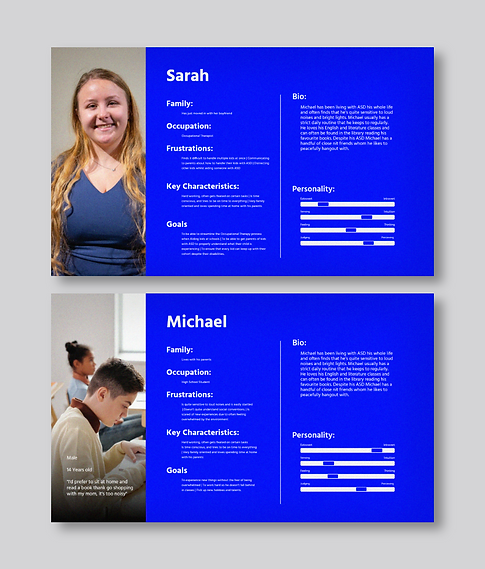Overseen by
Jon-Erik-Andreassen
Year
2021
Underload
An application helping people deal with their sensory processing problems. The application uses virtual reality to create Sensory safe spaces based on the user's needs. This was my final project for my 4 year degree at Monash University, winning a 'Highly Commendable award'.






Defining the problem
Research, Personas, Flowcharts, Wireframes

Problem Space
A problem that exists for people with ASD (Autism Spectrum Disorder) and their parents is a lack of resources or skills to deal with sensory problems without an Occupational Therapist. The complex nature of sensory processing problems and the lack of resources can often make dealing with this issue highly problematic for parents and carers. This also has an affect on the people with ASD, as they could potentially battle experiencing new environments in fear of being overwhelmed.
My Solution to this problem was to create an application that can help parents help their kids with their sensory needs. After extensive research and finding out their needs, felt that using Virtual Reality to help create safe space and help them acclimate to new environments would be a very useful feature. Furthermore, the app will help parents set up a relevant profile and create a tailored sensory experience schedule (sensory diet), to meet their sensory needs.

Personas
After interviewing a few occupational therapists, and observing the behavior of a few people with ASD, I was able to generate 2 personas relating to people who would interact with the application.

Heuristic Ideation
After interviewing Occupational therapists, and conducting extensive research, there were three important characteristics that the platform needed: convenience, portability and adaptability. The features In the application have to feature the various needs that I found were important to those with sensory processing problems and the people helping them: a sensory diagnosis, a sensory diet, a safe space, sensory acclimation to new places, additional sensory input for those that fit into a registration or seeking sensory profile and helping multiple users with different sensory needs. I decided to cross check these features the the three characteristics I had specified earlier with a Heuristic Idealization technique and was able to flesh out each need into a feature.

Flowchart
After Ideating and fleshing out the features I wanted to figure out the flow. Considering that personalisation was considered a key characteristic, I wanted the quiz to be done first so that the rest of the application ca be appropriately shaped around their needs. In addition to that I wanted some flexibility, making the completion of the quiz optional but prioritised.

The Solution
ios, prototype, User Interface, VR

Sensory Test
Often it can take a while to diagnose and get an understanding of someone’s sensory needs, especially when it requires the help of trained professionals. Underload can streamline a lot of that process in the Sensory Test. With questions on behaviour, Movement, Sounds, visuals and touch, Underload can give a summary of their sensory needs whilst automating a lot of other features.

Sensory Diet
A sensory diet is a crucial sensory input schedule allowing people with sensory processing problems to get their sensory needs. Whilst Virtual reality can help with visual and auditory input, it can’t provide proprioceptive, vestibular or tactile sensations, which is why this feature is crucial. Underload automates this by generating a diet based on the sensory test. A lot of people also have different needs or require a flexible sensory diet which is why new tasks can be added at any time.

Acclimation VR
In addition to shielding people from environments that can be potentially overwhelming, it’s just as important to let them sensitise towards it. This feature uses virtual reality to slowly introduce elements of an environment that require more sensory input. Often beginning easy, by letting the User choose where they start, it allows them to experience the environment at their pace without the fear of being overloaded with sensory input.

Safe Space Environments (VR)
With careful research into the different types of sensory profiles and their sensory needs, Underload can cater to individual sensory needs. With a shape guessing game, a breathing exercise, a relaxing creek and a neon disco, these environments help provide the user with either less or additional sensory input, ensuring that they can escape a sensory overload at any point.
